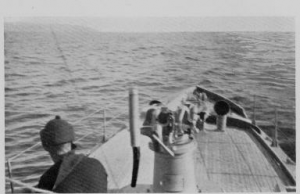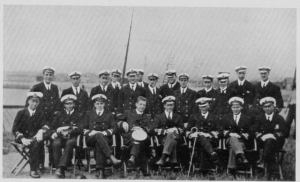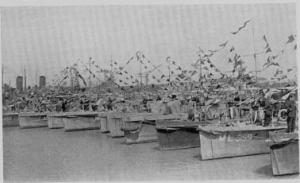The Auxiliary Patrol by E. Keble Chatterton
Prolific naval author E. Keble Chatterton produced The Auxiliary Patrol to document the work of the smaller, lesser-known craft of the navy during the war—primarily craft of the Dover Patrol. The ML is well treated and numerous photographs I've not seen elsewhere are provided. Included here are excerpts from the introductory chapter to the book along with various images of ML's scattered throughout. Chatterton's introduction gives a good hint at the improvised and very non-traditional flavour of this new aspect of the Royal Navy—a sense even more clearly conveyed by Gordon Maxwell in The Motor Launch Patrol. The men of the Auxiliary Patrol may have been professional sailors but they were largely not professional soldiers.
Prolific naval author E. Keble Chatterton produced The Auxiliary Patrol to document the work of the smaller, lesser-known craft of the navy during the war—primarily craft of the Dover Patrol. The ML is well treated and numerous photographs I've not seen elsewhere are provided. Included here are excerpts from the introductory chapter to the book along with various images of ML's scattered throughout. Chatterton's introduction gives a good hint at the improvised and very non-traditional flavour of this new aspect of the Royal Navy—a sense even more clearly conveyed by Gordon Maxwell in The Motor Launch Patrol. The men of the Auxiliary Patrol may have been professional sailors but they were largely not professional soldiers.
CHAPTER I
INTRODUCTION
I think that no evidence can be more eloquent of a nation's seamanhood than the work performed by this improvised new Navy. At the signing of Armistice there were thirty-nine thousand ranks and ratings of the Trawler Reserve alone, of whom a quarter were employed mine-sweeping. We knew during the war that German officers and men of the U-boat service held our Auxiliary Patrol in awe, because they frequently ran away from our improvised craft, and on occasions when these armed yachts, fishing vessels, or motor craft destroyed enemy submarines, the prisoners were only too ready to admit their feelings verbally. It would be easy to adduce plenty of evidence since the war, but two independent German naval officers will suffice.
INTRODUCTION
I think that no evidence can be more eloquent of a nation's seamanhood than the work performed by this improvised new Navy. At the signing of Armistice there were thirty-nine thousand ranks and ratings of the Trawler Reserve alone, of whom a quarter were employed mine-sweeping. We knew during the war that German officers and men of the U-boat service held our Auxiliary Patrol in awe, because they frequently ran away from our improvised craft, and on occasions when these armed yachts, fishing vessels, or motor craft destroyed enemy submarines, the prisoners were only too ready to admit their feelings verbally. It would be easy to adduce plenty of evidence since the war, but two independent German naval officers will suffice.
Admiral Koch, who was formerly Deputy Chief of Staff under the late Admiral von Holtzendorff, officially admitted that the success of the British anti-submarine measures was due to listening-ships and to fast surface-ships which compelled the U-boats to remain so long submerged, and to the convoy system. Now, if we omit the destroyers, and (later on) the P-boats, the motor-launches were the only fast surface-craft which were employed, until the high-powered coastal motor-boats were introduced for service chiefly off the Belgian coast. Over and over again there are instances of steel-built U-boats being frightened by the ML's, and in particular I recollect one such submarine running away for her life. In almost every case the U-boat was immensely superior in armament, and, if she had liked to remain, she could have chosen her own range and shelled the ML to destruction; for no motor-launch was ever armed with a bigger gun than a 13-pounder, and those in home waters soon changed for a smaller calibre. On the other hand, the enemy's submarine operating off our coasts usually carried not less than one 4.1 inch, quite apart from a 22-pounder, one machine-gun, and her torpedoes. Yes, those thin, wooden motor-launches, manned chiefly by amateur yachtsmen, were among the most effectual instruments of the anti-submarine campaign, and caused the enemy to become far more terrified than one would have imagined justifiable.
Korvetten-Kapitan Erich Edgar Schuize has similarly paid a tribute to our Auxiliary Patrol which operated off the Belgian coast, and refers to the seaman-like skill with which our net barrage was laid. Commander Schulze refers to the vigilance of our patrols off that littoral during the last year of the war, compelling the Germans to make dashes in varying directions at high speed whenever they essayed to emerge. Let it be remembered, then, that the barrage was laid by drifters, and that motor-launches were chiefly responsible for patrolling this barrage. We shall consider the subject in greater detail in its chronological place.
Korvetten-Kapitan Erich Edgar Schuize has similarly paid a tribute to our Auxiliary Patrol which operated off the Belgian coast, and refers to the seaman-like skill with which our net barrage was laid. Commander Schulze refers to the vigilance of our patrols off that littoral during the last year of the war, compelling the Germans to make dashes in varying directions at high speed whenever they essayed to emerge. Let it be remembered, then, that the barrage was laid by drifters, and that motor-launches were chiefly responsible for patrolling this barrage. We shall consider the subject in greater detail in its chronological place.
Appendix IV
Notes on the Passage of ML's from Portsmouth to the Mediterranean
The interesting voyage of the motor gunboat California to the Mediterranean in 1915 was to be repeated by other craft two years later. The problem was that, although the newly built motor launches were much required in the Middle Sea owing to the extended activities of enemy submarines, there was such a heavy demand on the fast-dwindling number of transports that there was not always room for these craft as deck cargoes. Moreover, there was always a possibility that if the transport were torpedoed the motor craft would also be destroyed. In this manner the three motor-boats Allegro, Doreen, and Griffin were lost in September, 1916, when the Achaia was torpedoed off Oran. There were cases where the motor craft actually floated off the sinking transport and thus were saved. And there were other cases where the motor craft from the deck of the transport brought their guns into action and actually shelled enemy submarines, thus largely contributing to the escape of the transport.
The month of July, 1917, was the time when the shortage of shipping and the activiites of the U-boats were already acute. A flotilla of eight motor launches was waiting at Portsmouth bound for the Mediterranean, and it was finally decided to send them out under their own power through the French canals and navigable rivers, Commander Smart, R.N.V.R., being again in command. [J. Charles note: Commander Morton Smart, R.N.V.R., one of the founders of the R.N.M.B.R. - the Royal Navy Motor-Boat Reserve - created early in the war to provide motor-boat protection on the rivers and canals first of France and later in the Mediterranean] The flotilla consisted of ML's 438, 505, 432, 440, 516, 539, 535, and 530. Leaving Portsmouth on July 11, they reached Havre and Rouen. After various adventures peculiar to the waterways of France, and being compelled to endure trying delays, they reached Marseille on the last day of the same month, not without damage to propellers owing to grounding or striking the lock sides or fouling submerged tree-branches.
Notes on the Passage of ML's from Portsmouth to the Mediterranean
The interesting voyage of the motor gunboat California to the Mediterranean in 1915 was to be repeated by other craft two years later. The problem was that, although the newly built motor launches were much required in the Middle Sea owing to the extended activities of enemy submarines, there was such a heavy demand on the fast-dwindling number of transports that there was not always room for these craft as deck cargoes. Moreover, there was always a possibility that if the transport were torpedoed the motor craft would also be destroyed. In this manner the three motor-boats Allegro, Doreen, and Griffin were lost in September, 1916, when the Achaia was torpedoed off Oran. There were cases where the motor craft actually floated off the sinking transport and thus were saved. And there were other cases where the motor craft from the deck of the transport brought their guns into action and actually shelled enemy submarines, thus largely contributing to the escape of the transport.
The month of July, 1917, was the time when the shortage of shipping and the activiites of the U-boats were already acute. A flotilla of eight motor launches was waiting at Portsmouth bound for the Mediterranean, and it was finally decided to send them out under their own power through the French canals and navigable rivers, Commander Smart, R.N.V.R., being again in command. [J. Charles note: Commander Morton Smart, R.N.V.R., one of the founders of the R.N.M.B.R. - the Royal Navy Motor-Boat Reserve - created early in the war to provide motor-boat protection on the rivers and canals first of France and later in the Mediterranean] The flotilla consisted of ML's 438, 505, 432, 440, 516, 539, 535, and 530. Leaving Portsmouth on July 11, they reached Havre and Rouen. After various adventures peculiar to the waterways of France, and being compelled to endure trying delays, they reached Marseille on the last day of the same month, not without damage to propellers owing to grounding or striking the lock sides or fouling submerged tree-branches.
Having been docked and repaired, ML's 535 and 505 proceeded under their own power to Gibralter, having left on the night of August 8 and arriving on the evening of August 11. This was no mean achievement, for it involved a run of about 700 miles with no intervening friendly port in which to run in case of necessity. They were escorted by H.M.S. Marguerite. The other six ML's after their repairs left Marseilles and proceeded on August 19 via Villefranche, Genoa, Spezzia, Leghorn, Civita Vecchia, Naples, Policastro, Messina; here ML's 438 and 432 parted company on their way to Malta. The other four reached Taranto on September 3, in twenty-six actual steaming days from Portsmouth, a distance of 2,246 miles.
The work performed by the craft based on the Otranto Straits is dealt with in another place, but it has been thought well to set down here these interesting details of the passage out, as showing the multifarious achievements of small craft during the war. It should be mentioned that all officers were not professional but amateur seamen, and fairly heavy seas were encountered in the Mediterranean, the craft themselves being built of wood, their length overall being eighty feet.
The work performed by the craft based on the Otranto Straits is dealt with in another place, but it has been thought well to set down here these interesting details of the passage out, as showing the multifarious achievements of small craft during the war. It should be mentioned that all officers were not professional but amateur seamen, and fairly heavy seas were encountered in the Mediterranean, the craft themselves being built of wood, their length overall being eighty feet.
The Auxiliary Patrol





